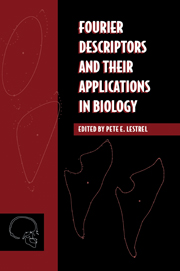Book contents
- Frontmatter
- Contents
- List of contributors
- Preface
- Acknowledgments
- Part one Theoretical considerations
- 1 Introduction
- 2 Introduction and overview of Fourier descriptors
- 3 Growth and form revisited
- 4 Methodological issues in the description of forms
- 5 Phase angles, harmonic distance, and the analysis of form
- Part two Applications of Fourier descriptors
- Appendix
- Glossary
- Index
1 - Introduction
Published online by Cambridge University Press: 14 September 2009
- Frontmatter
- Contents
- List of contributors
- Preface
- Acknowledgments
- Part one Theoretical considerations
- 1 Introduction
- 2 Introduction and overview of Fourier descriptors
- 3 Growth and form revisited
- 4 Methodological issues in the description of forms
- 5 Phase angles, harmonic distance, and the analysis of form
- Part two Applications of Fourier descriptors
- Appendix
- Glossary
- Index
Summary
Entia non sunt multiplicanda praeter necessitatem.
Entities are not to be multiplied beyond necessity (Ockham's Razor).
William of Ockham (1300–1349)The study of form may be descriptive merely, or it may become analytical. We begin by describing the shape of an object in simple words of common speech: we end by defining it in the precise language of mathematics; and the one method tends to follow the other in strict scientific order and historical continuity.
D'Arcy Thompson (1915)Introduction
Advances in the biological sciences often proceed on a number of fronts, which include (1) development of theoretical frameworks (formal model building); (2) development of appropriate tools; and (3) applications based on various techniques (using data) to solve problems. All three of these approaches are conceptually linked and need to proceed simultaneously if progress is to be made. Generally, specific data-oriented problems tend to spearhead the need for new techniques leading to new algorithms. These in turn may lead to a reevaluation of accepted theory or assist in the development of new formal models. Often, applications and algorithms tend to outrun the development of formal models.
There also seems to be a distinction between practitioners who might be called “theoreticians” for the lack of a better word, and those who are “practitioners”.
- Type
- Chapter
- Information
- Publisher: Cambridge University PressPrint publication year: 1997
- 7
- Cited by



